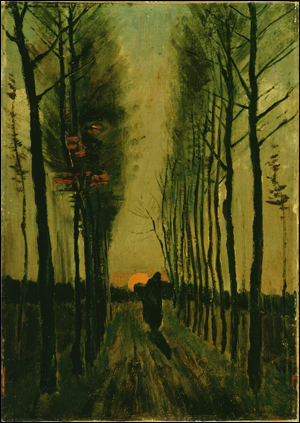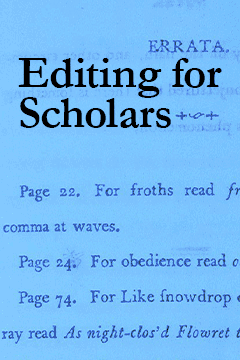Beauty and Justice: Van Gogh at the MoMA
Beauty and Justice: Van Gogh at the MoMA
N. Mills: Van Gogh at the MoMA
2008 has been a year of blockbuster art shows at New York’s Metropolitan Museum of Art. But the New York show that promises to be the most memorable of 2008 is no blockbuster. It is the Museum of Modern Art’s “Van Gogh and the Colors of the Night.” With just 23 paintings and nine drawings hung in six small galleries, the van Gogh show is so small that MoMA uses special tickets to limit the number of people allowed in at one time.
Fifty years before van Gogh began doing his night paintings, Ralph Waldo Emerson observed in the opening chapter of Nature: “If the stars should appear one night in a thousand years, how would men believe and adore; and preserve for many generations the remembrance of the city of God which has been shown!”
The brilliance of the MoMA exhibit, which has been organized with the Van Gogh Museum in Amsterdam (where it will go after it closes in New York on January 5), is that it captures what Emerson regarded as the miraculous, letting us see how van Gogh’s painting technique evolved over the course of the 1880s.
 Van Gogh’s fascination with the night began with his “Twilight, Old Farmhouses in Loosduinen” (1883) and “Lane of Poplars at Sunset,” painted a few months later in 1884. The flat brushwork in these paintings is unremarkable, but the orange sun nearing the horizon in “Lane of Poplars at Sunset” hints at the change about to come in van Gogh’s work. A year later in “The Potato Eaters,” the direction in which van Gogh was headed becomes evident and so, too, does the fact that he was in the process of changing the sentimental approach to rural life that was so central to such French paintings as Jean-Francois Millet’s “The Sower” and Jules Breton’s “The Feast of St. John.”
Van Gogh’s fascination with the night began with his “Twilight, Old Farmhouses in Loosduinen” (1883) and “Lane of Poplars at Sunset,” painted a few months later in 1884. The flat brushwork in these paintings is unremarkable, but the orange sun nearing the horizon in “Lane of Poplars at Sunset” hints at the change about to come in van Gogh’s work. A year later in “The Potato Eaters,” the direction in which van Gogh was headed becomes evident and so, too, does the fact that he was in the process of changing the sentimental approach to rural life that was so central to such French paintings as Jean-Francois Millet’s “The Sower” and Jules Breton’s “The Feast of St. John.”
In “The Potato Eaters,” the grimness of rural life, reminiscent of that portrayed by his contemporary Emile Zola in his Germinal of 1885, sets the tone for van Gogh’s portrait of a farm family eating a meager dinner of potatoes (washed down with coffee) in a lamplight that barely illuminates their gaunt features. The meal and the joyless looks of the family suggest that all they have to anticipate for the future is more hard work and not enough to eat. But what makes the picture most compelling are the colors van Gogh employs in depicting the darkness that dominates the room in which his potato eaters take their meal. The faces of van Gogh’s family are a sooty brown. Their clothes are a grim gray-green, and the shadows surrounding them are a Prussian blue. It is not the night so much as all that should provide relief from darkness that makes “The Potato Eaters” depressing. Small wonder that van Gogh later observed of his painting, “I wanted it to give the idea of a wholly different way of life from ours.”
The triumph of “The Potato Eaters” sets the tone for the rest of the paintings in “Van Gogh and the Colors of the Night.” In all the work that we see in the remaining four MoMA rooms, it is clear that color has become far more important for van Gogh than the literal rendering of a scene. This emphasis is particularly visible in the stunning purple fields of “The Sower” (1888) and in the thick brown, green, and blue brushstrokes of “Landscape with Wheat Sheaves and Rising Moon” (1889). But it is in the two paintings that dominate the conclusion of the exhibit, “The Starry Night Over the Rhone” (1888) and “Starry Night” (1889), that van Gogh’s use of color reaches a whole new level.
 The multitude of stars in these two paintings only begins to explain the awe they evoke. Especially in “Starry Night,” the viewer’s attention is drawn to the sky itself, with its swirls of varying shades of blue, and when we look at the stars that fill this sky, they are nothing like the tiny points of light that we are accustomed to gazing at on a clear night. The stars van Gogh shows us consist of a series of radiating halos of green, blue, and white with yellow centers. They are his unique creation, and as we stare at them and the crescent moon in the upper right quadrant of his painting, it seems only natural that the cypress trees and houses of the small village below should take on a miniaturized perfection of their own. Beneath such a wondrous night sky, nothing can ever be just ordinary.
The multitude of stars in these two paintings only begins to explain the awe they evoke. Especially in “Starry Night,” the viewer’s attention is drawn to the sky itself, with its swirls of varying shades of blue, and when we look at the stars that fill this sky, they are nothing like the tiny points of light that we are accustomed to gazing at on a clear night. The stars van Gogh shows us consist of a series of radiating halos of green, blue, and white with yellow centers. They are his unique creation, and as we stare at them and the crescent moon in the upper right quadrant of his painting, it seems only natural that the cypress trees and houses of the small village below should take on a miniaturized perfection of their own. Beneath such a wondrous night sky, nothing can ever be just ordinary.
The end result is not, however, a vision that minimizes the rural poverty depicted in “The Potato Eaters.” Rather it is a vision of the heavens—theological at its core—that suggests if we are to experience the sublime that surrounds us, we cannot be so deprived of our basic needs that the task of fulfilling them requires all our energies. For van Gogh, beauty and justice are, it turns out, inextricably linked.
Nicolaus Mills, a professor of American Studies at Sarah Lawrence College, is author of Winning the Peace: The Marshall Plan and America’s Coming of Age as a Superpower. Homepage and feature paintings courtesy of MoMA.




